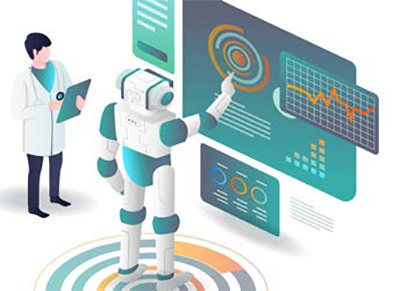Digital health is a highly interdisciplinary field at the intersection of technology and medicine. Emerging applications include mobile health, telemedicine, and precision medicine. Stakeholders include patients, physicians, and researchers in academia, industry, and government. In this interview, a radiology physician-scientist reflects on the history and future of the specialty.
I am a radiology physician-scientist with engineering training and practice experience at multiple hospitals across the United States. In my current position, I balance clinical, research, and administrative responsibilities. When on clinical service, I spend my time interpreting medical imaging examinations and consulting with physicians in various specialties to help them diagnose and manage patients. My research time is spent working alongside basic scientists and data scientists to improve the methods by which we acquire and analyze medical images. In my various leadership roles, I mentor other faculty and trainees, develop educational and diversity programs, build bridges between departments, and partner with other medical centers for global impact.
During COVID-19, the need for social distancing and quarantine greatly accelerated the adoption of digital health solutions. There was a powerful demand for mobile health, telemedicine, and precision medicine approaches. International collaborative teams were formed to facilitate big data sharing and analytics for real-time clinical tracking, multicenter research, and 3D printing/simulation. In the postpandemic era, these initiatives have continued to progress toward the ultimate vision of a holistic and patient-centered model of population health, in which digital technologies are used to deliver value-based care and reduce socioeconomic disparities by predicting and preventing disease throughout the general community.

There is a looming crisis in healthcare related to the aging of our global population, overutilization of hospital resources, and medical staff burnout. Digital health could help move us toward general surveillance and preventative care before people ever reach the hospital, thus decreasing the overall burden on our healthcare system. Wearable monitoring devices, personalized assessment, and early interventions in lifestyle could help modify risk factors for subjects. For patients that do require medical care, we would be able to better diagnose and treat them using approaches tailored to their demographics and disease type. This is the grand vision of precision health: improved risk assessment and prognosis, earlier and more accurate disease diagnosis, and minimally invasive and targeted therapies to achieve best patient outcomes. However, this lofty goal will require international collaborations across multiple specialties to acquire the vast information required for “data-hungry” AI algorithms to derive complex patterns and accomplish large-scale predictions.
The four principles of medical ethics are autonomy, non-maleficence, beneficence, and justice. When applied to AI, the key considerations include bias/discrimination, privacy/surveillance, and accountability/responsibility. There are many potential sources of bias at the levels of problem selection, data collection, outcome definition, algorithm development, and postdeployment surveillance. The overwhelming majority of hospital admissions, clinical trials, and practice guidelines are derived from adult Caucasian males. Therefore, AI algorithms trained on these datasets will encode implicit bias and further exacerbate social inequities. Additional efforts must be made to train, validate, and test algorithms on underrepresented groups (gender, race, country) to ensure fair and robust results. Furthermore, with the standard “black box” approach providing limited access to inputs and operations, AI algorithms are not readily transparent or explainable. Thus, the use of AI may lead to medical mistakes or data breaches with devastating consequences for patients. Human oversight will be important to identify and address the sometimes unpredictable biases of AI, as exemplified by recent controversies around Watson, ChatGPT, and Bing.
Compared to conventional technology startups, the medical technology field is far more demanding and limited by regulatory considerations related to patient safety. The old Silicon Valley principle of “fake it till you make it” does not apply, as we have seen with companies like Theranos. Currently, the majority of MedTech ideas are overhyped, reflecting the persistent gap between commercial startups and clinical practice. In general, tech companies deal in “blue sky” thinking and are focused on a path to funding and acquisition. Industry vendors have limited understanding and appreciation for the logistics of routine clinical care. The few physicians employed in industry tend to be administrators and researchers who have moved away from traditional clinical care. On the flip side, clinicians are incredibly busy with patient responsibilities and are far more realistic about viable use cases. Furthermore, physicians do not have time to curate and annotate large amounts of data for AI training, unlike the general crowdsourcing of Mechanical Turk. Even some of the closest MedTech collaborations have failed due to the disconnect between vendors, who are primarily interested in acquiring patient data and finding quick routes to market; and hospitals, which want to protect their individual datasets and develop clinically relevant solutions. To bridge this divide, we need to improve public-private partnerships and invest the time and resources necessary to solve truly challenging problems in medicine.
All of these are very important considerations for healthcare. Ultimately, digital health solutions need to be readily available to “anyone, anywhere, anytime.” Interoperability ensures that patients and various health systems can effectively exchange and utilize information. Cyber security is important to protect organizational applications, data, and infrastructure from attack. Ethical AI seeks to provide inclusive, transparent, and explainable solutions for data analysis and management. As we learn more about AI and its pitfalls, we can begin to incentivize its positive and responsible use with public sector policies and formal legislation.

As I mentioned, there is a fundamental breakdown in communication between industry vendors and medical practitioners. Burnout is prevalent in healthcare, and the last thing people want to do is expend more effort to train a machine intended to “replace” or “perform better than” them. That has always been an unrealistic goal, and vendors are gradually coming to realize that they need to target more practical or narrow AI applications that encourage human-machine synergy. Ideally, digitization will bridge the gap between “healthy” and “diseased” populations by identifying at-risk individuals in the community, providing longitudinal counseling and feedback, and improving workflows for those admitted to the hospital. Modern machines are replacing many lower-level and mundane tasks that have comprised traditional human work. This could theoretically improve efficiency by freeing up individual time for more meaningful work, and reducing overall strain on the healthcare system.
COVID-19 was a catalyst for open-source and real-time data sharing/tracking, both for epidemiological monitoring and other multicenter collaborations. In the postpandemic era, there is continued interest in digital technologies and accelerated innovation. We should sustain this momentum by building global informatics infrastructure and scalable public-private partnerships for data-driven and evidence-based medicine. Unfortunately, large-scale implementation will be hindered by corporate interests, political considerations, and socioeconomic disparities. From a logistical standpoint, many centers are moving toward training on-premise resources (edge computing) on “small and wide” datasets that represent the local population, but are still diverse enough to provide viable AI solutions.
Several digital health technologies and tools are predicted for 2023. On the clinical side, we have increased consumerization with mobile options for preventative health, remote patient monitoring, and virtual doctor appointments. There is particular interest in elevating services for mental health, women’s health, and rural health. AI tools are improving physician workflow at multiple levels with clinic scheduling, patient prioritization, entering notes and orders, clinical decision support, and business analytics. In research, we are seeing the emergence of decentralized clinical trials to facilitate patient recruitment and access with digital tracking and reporting. Recent studies are utilizing digital biomarkers of disease (real-time tracking and radiologic data) and leveraging strategies to accelerate the drug development life cycle. Digital technologies can also provide feedback to assist patients with monitoring, rehabilitation, and behavioral therapies. Finally, bioinformatics tools are increasing our ability to mine large datasets for clinically relevant information and integrate disparate sources of information to guide patient diagnosis and management.

As I mentioned, most MedTech startups do not appreciate the challenges of real-world patient care and operationalization. I would exhort companies not to aim only for the low-hanging fruit, or seek to reinvent the wheel with variations on ideas that aren’t truly helpful (and may actually do harm to patients). Don’t be afraid to invest in higher-risk and clinically meaningful questions, as long as you have robust clinical partners. Vendors need to engage actively practicing physicians who know the field and understand real-world problems. This can be accomplished by attending professional meetings, developing organic relationships, soliciting feedback, and respecting the input of expert consultants. Finally, clinicians are incredibly busy, and their first responsibility is to their patients. For any hospital collaboration, there will be wide-ranging legal and ethical considerations to be addressed with regard to training AI algorithms and sharing protected health information. Therefore, we need to target patient-centric models that provide optimal patient experience and value-based care.
Like many universities, we have undergone major leadership transitions and challenges with finances and staffing shortages during the pandemic. Currently, the strategic focus is on building informatics infrastructure to streamline innovation and collaboration. Robust information technology pipelines are central to advancing clinical excellence and research initiatives in neuroscience, oncology, and cardiovascular care. A major initiative aims to link our adult and pediatric electronic health records (EHRs), thus improving continuity of care across the lifespan. Our university is also a world leader in digital pathology and genomics, which could be integrated with the EHR and other medical imaging databases (radiology, cardiology, gastroenterology) within a common vendor neutral archive (VNA) to enable precision health approaches.
Radiology is an incredibly intellectual specialty—we touch almost every patient in the hospital, noninvasively image a wide range of pathologies, and serve as consultants to various physicians and scientists. As a result, we are constantly learning and adapting to new advances in imaging technology, clinical care, and data science. I truly enjoy working at the interface of multiple areas within science, engineering, and medicine. By participating on both the clinical and research sides, I can contribute to “bench-to-bedside” translation at multiple levels.
Women have been held back professionally throughout history, but the outlook continues to improve. In light of recent social justice movements and elevated interest in workplace diversity, there is no time like the present to build on the advances of our forebears. To quote Eleanor Roosevelt, “The world of the future is in our making. Tomorrow is now.” Self-knowledge is critical: reflect deeply on what you want out of life, and actively pursue your unique goals, rather than passively letting society decide your path for you. Seek out good role models, mentors, and sponsors early in your career—both supportive women and male allies—and commit to serving in that role for others. Finally, resilience is key; there is no success without failure. Over the course of your career, you will inevitably encounter both personal and professional setbacks, and how you respond to those makes you stronger.